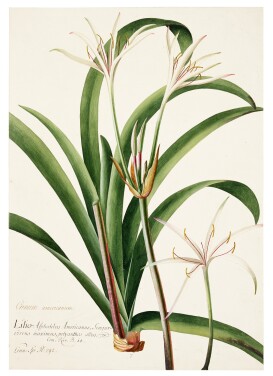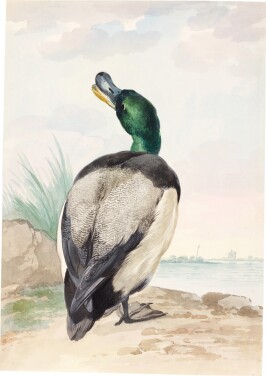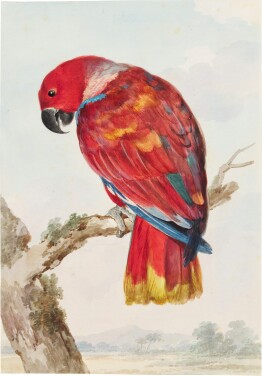S otheby's proud to present a selection of Exceptional natural history watercolours from the collection formed by Henry, 2nd Lord Fairhaven (1900-1973). Leading the collection, A group of drawings by the celebrated and miraculous botanical artist Georg Ehret.
Georg Dionysius Ehret
From humble and obscure beginnings Georg Dionysius Ehret, (1708-1770) rose to take his position as one of the greatest botanical artists of his or any age, keenly patronised by princes, aristocrats and leading scientists. Sotheby’s is delighted to offer for sale a group of seven watercolours from the prestigious Fairhaven Collection, which show this master working at the peak of his powers.

Born in Heidelberg in January 1708 to Ferdinand Christian and Anna Maria Ehret, the future artist was encouraged to draw from a very early age. His father, uncle and stepfather (his father having died when Georg Dionysius was still very young) were all gardeners and Ehret followed them into this profession – firstly taking up a position with the Elector Palatine of Heidelberg and then, a year or two later, with Margrave Karl III, Wilhelm of Baden-Durlach at Karlsruhe. The Margrave had a great interest in botany and his collections comprised: ‘6,000 orange trees, 5,000 varieties of tulips, 800 varieties of hyacinths, 400 Ranunculi, 200 Anemones, 100 daffodils, 500 Auriculas and 600 varieties of carnation.’1 His employer’s enthusiasm for exotic species cemented Ehret’s own feeling for the subject and, by the late 1720s, he had turned his full attention to painting.
Ehret left the Margrave’s service in 1728 and, over the next five years, was engaged in several large-scale artistic projects for a variety of willing patrons. In 1731, through his great friend, Ambrosius Beurer (1716-1754), he began to correspond with Dr Christopher Jakob Trew of Nuremberg (1695-1769), a physician, scholar, collector of natural objects and a passionate botanist. The two men first met in 1733 and they were to remain close for the remainder of their lives. Ehret regularly corresponded with Trew and often sent him botanical drawings. It was Trew who instilled in the young painter the importance of wide travel and opened his eyes to the groundbreaking developments of botany: the discovery of new species and scholars’ efforts to categorise and catalogue the natural world. He also suggested that Ehret could help advance this new science through painting.
In 1734, Ehret travelled to France. He was introduced to Monsieur du Fay, the director of the Jardin du Roi, and spent the winter of 1734-1735 living in accommodation in the Jardin des Plantes. Here, he gained access to the Royal collections of botanical paintings and drawings, which dated back to the mid-17th century, and for the first time he began painting on a vellum support rather than paper. While in Paris, he also encountered Bernard de Jussieu (1699-1777), a key member of the Académie Royale des Sciences and France’s preeminent botanist.
In February 1735, Ehret left France for England, with a passport signed by the King himself and letters of introduction to grandees such as the Duke of Richmond and Sir Hans Sloane, the president of the Royal Society. The following year, he travelled via Leiden to Amsterdam, where he met Carl Linnaeus, the Swedish botanist, whose system of plant categorisation revolutionised the field. At that time, Linnaeus was working on his Hortus Cliffortianus, which had been commissioned by George Clifford of Hartekamp, a banker whose family originated from Lincolnshire. Ehret was to contribute twenty engravings to that project.
Deciding to return to England, for the next thirty-four years Ehret would call that country his home. He lived in Chelsea with, or near to, Philip Miller (1691-1771), the curator of the Physic Garden and in 1738, married the sister of Miller’s wife, Susanna Kennet, with whom he had three children. Over the years, his reputation only grew, and he enjoyed a steady stream of commissions not only from patrons keen to acquire original drawings but also from scholars wanting him to supply plates for their publications.
Ehret also became a highly sought-after drawings master to aristocratic ladies. His charges, to name but a few, included Catherine, Duchess of Norfolk, Mary, Duchess of Leeds, and the daughters of the Duchesses of Portland and Bridgewater, and the Duke of Kent. Not bad for a self-taught boy from Baden-Württemberg!
Gerta Calmann, the art historian and author of Ehret: Flower Painter Extraordinary (1977) perhaps summed up his particular genius best when she wrote: ‘Ehret was carried on the voyage of the enlightened interest in natural science of his time. His talent and his skill, his energy and good temper recommend him now as they did in the past… His coloured drawings have an immediacy and a spirituality, which express his wonder and delight before nature. In each work, he preserves for us the transient beauty of a flower and his vision of it remains.’2
The four outstanding watercolours by Ehret that are offered in this sale originally formed part of the collection of Henry, 2nd Lord Fairhaven (1900-1973) and they have remained with his descendants until today. Lord Fairhaven assembled a very extensive collection of botanical drawings of the highest quality in his lifetime. On his death in 1973, his executors bequeathed some 4,000 works of this type to the Fitzwilliam Museum, Cambridge, including ninety-four drawings by Ehret. See also the works by Aert Schouman and Charles Collins, lots 62-66 in this sale, and a further selection of watercolours by the same artists, to be offered in the concurrent online sale of Old Master & British Works on Paper (2-8 July).
Aert Schouman
As the recent encyclopaedic exhibition of his work richly demonstrated3, Aert Schouman (Dordrecht 1710 - 1792 The Hague) was a talented, prolific and versatile artist, working across many genres and artistic disciplines, including portraiture, landscapes, wall decorations, paintings, drawings and prints. He is, though, perhaps best known for his detailed studies of animals and birds, many of them drawn from specimens that he observed at Royal and aristocratic menageries and natural history collections, notably that of the Stadholder Willem V (1748 – 1806).

Born in Dordrecht in 1710, Schouman began his artistic training with the painter Adriaan van der Burg (1693-1733). Inspired by the training he received, Schouman himself became a teacher in 1733 and continued to teach for the remainder of his life. He retained the position of Director of the Dordrecht Guild of St. Luke from 1742 until 1792. In 1736 he founded the Confrerie in The Hague, a fraternity of amateur art enthusiasts from Dordrecht and the surrounding regions. During his career, he travelled to England, and assembled a notable collection of paintings.
Prior to the Dordrecht Museum exhibition, the most significant showing of the artist’s work in recent times was in 2004, when the collection of Saam and Lily Nijstad was sold at Sotheby’s Amsterdam, presenting no fewer than twenty-five drawings by Schouman, which demonstrated the Dordrecht master’s exceptional range and talent.4
These three fine watercolours from the Fairhaven Collection, depicting a Scarlet Macaw, two Red-legged Partridges and a Mallard Drake, are all exceptional examples, in both quality and condition, of Aert Schouman’s celebrated bird studies. They illustrate the artist’s preferred formula for presenting his natural history subjects: one or two specimens, often exotic rather than native, whenever possible drawn life-size, with minimal landscape as a backdrop. Many of his drawings, like the present examples, are inscribed on the verso, often with details of the species depicted, some with his initials and date and some indicating where he studied the actual bird or animal that is shown.
Charles Collins
Charles Collins was born in Dublin to unknown parentage. At some point he moved to London, whereupon he proceeded to established himself as a specialist animal and still-life painter. He painted both large compositional pictures in oil, and single species portraits in watercolour and bodycolour. A highly gifted artist, he possessed the ability to bring his subjects to life and, as the group presented for sale in this series of auctions demonstrates, his eye for detail and sense of colour were remarkable. Examples of his work are held in the British Museum, City of Birmingham Museum and Art Gallery, the National Gallery of Ireland and at McGill University, Montreal.
1. G. Calmann, Ehret: Flower Painter Extraordinary, London, 1977, p. 15
2. Ibid, p. 116
3. Een koninklijke paradijs, Aert Schouman en de verbeelding van de natuur, Dordrechts Museum, 2017
4. Sale, Amsterdam, Sotheby's, The Unicorno Collection: Fifty-five Years of Collecting Drawings, 19 May 2004, lots 204-224















